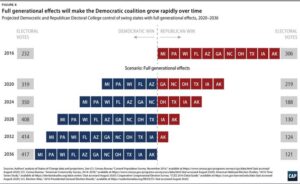There is an ongoing argument about how much newspaper endorsements of political candidates actually matter in the digital age. But any presidential candidate would rather have, than not have, the endorsement of the major daily newspaper of Florida’s second largest metropolitan area. So, here are some excerpts from the well-reasoned Tampa Bay Times endorsement of Joe Biden for President of the United States:
Joe Biden should be our next president. A battered and divided country must hit the reset button. The nation needs a leader who can pull us back together, who wants to pull us back together. Sure, disagree on policies and debate the issues. But a president should not routinely sow discord. Self-promotion should not be his best skill. Our allies should not wince when the president speaks. The less fortunate should feel they are a part of us, not castoffs on a cruel game show. Biden promises needed change. The alternative could be perilous for our democracy.
Biden knows tragedy, and he’s at his best when talking about moving beyond it. He lost a wife and infant daughter to a car accident and an adult son to a brain tumor. He speaks of pain and healing and recovery — with authority and empathy. He comforts military families, knowing how it feels to send a son into a combat zone. He still believes in the legislative process, even when it’s divisive and bogged down. He hasn’t lost his faith in the system and looks for ways to bring sides together. Biden is not afraid of the hard work involved in finding common ground. To him, compromise isn’t a dirty word, but he’s also known to fight hard for what he believes, like when he championed the Violence Against Women Act in the 1990s…Trump is angry, divisive, entitled. Biden is open, empathetic, caring. He would return decency and decorum to the presidency, a welcome example at home and abroad.
Credit the TBT editorial board with understanding that Americans are sick of Trump’s polarizing rhetoric and his daily deluge of rancid insults and threats. It’s no accident that Biden, the Democrat who articulates a vision of healing and unity, won his party’s nomination. The endorsement continues,
Biden’s adversaries try to paint him as beholden to liberal extremists, but the record exposes that tired political tactic. He has worked with Republicans on foreign policy and criminal justice. He has backed protesters’ right to protest, but condemned looting and violence. He’s a centrist, willing to push big ideas, but also capable of keeping his own party’s left wing in check.
Biden’s sensible, pragmatic approach to leadership will help the country combat the coronavirus. He has vowed to be transparent about who’s contracting the disease and how often. He’ll trust the experts and the scientists as we push for a vaccine. He won’t rush the recovery to score political points. To protect himself and those around him, he’ll wear a mask, setting an example of good judgment.
In stark contrast, the TBT editorial board notes, “At the outset, Trump publicly pooh-poohed the virus, even as he was privately telling journalist Bob Woodward it was a grave danger. There is no better example of Trump’s central character flaw: He will always put self-interest above national interest.” Further, “Where Trump and his allies want to take away access to health care, Biden will work to improve and expand it, including lowering the eligibility age for Medicare from 65 to 60. He would keep the Affordable Care Act and try to reinstate the parts eroded during Trump’s tenure. He proposes capping health insurance premiums at 8.5 percent of family income.” Trump, on the other hand has failed to come up with anything resembling a health care plan, and he gutted the CDC’s capacity to address the pandemic.
The endorsement also holds Trump accountable for his grotesque abuse of the presidency, noting that “Trump has undermined democracy at every turn, belittling American institutions including the intelligence community, wailing about “rigged” elections, flirting with white supremacists, cozying up to dictators, dismissing established science, and attacking anyone who disagrees with him — even those who have served his administration.” In addition,
Trump hasn’t created law and order, as he often boasts. To the contrary, he has fanned violence with his rhetoric, and he shows little respect for the rule of law. When his longtime ally Roger Stone was convicted of making false statements, witness tampering and obstructing in connection with the probe into Russian interference in the 2016 presidential election, Trump came to the rescue by commuting his sentence. Trump’s cronies get indicted and convicted at an astounding rate. He’s also pardoned several of his lawbreaking friends and supporters, a trend surely to continue if he is elected to a second term…Trump loves to bluster, hates to plan, revels in chaos and lacks concern for anyone but himself. He is hurting America.
An apt summary of the damage done to America by Trump. Looking toward the future, the Tampa Bay Times editorial board concludes: “Over a long career and the gantlet of a presidential campaign, Biden outmatches his opponent at every turn. He’s a decent man and a leader who can help heal the country and put it back on course to meet the pressing challenges of our times. America needs a new president. TheTampa Bay Times Editorial Board strongly recommends Democrat Joe Biden.”




